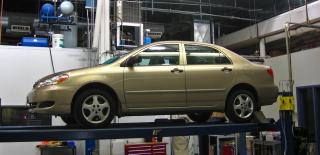Riding eastward across Ottawa from Booth Street towards Sandy Hill, it is far wiser to head north to the river and follow the riverside path than it is to push straight through Centretown. The most obvious reason for this is aesthetic, since the path offers a beautiful view of the river and Parliament Hill. A more technical reason has to do with traffic dynamics. As this paper on bicycle commuting explains:
Bicyclists can work only so hard. The average commuting rider is unlikely to produce more than 100 watts of propulsion power, or about what it takes to power a reading lamp. At 100 watts, the average cyclist can travel about 12.5 miles per hour on the level. When necessary, a serious cyclist can generate far more power than that (up to perhaps 500 watts for a racing cyclist, equivalent to the amount used by a stove burner on low). But even if a commuter cyclist could produce more than 100 watts, she is unlikely to do so because this would force her to sweat heavily, which is a problem for any cyclist without a place to shower at work.
With only 100 watts’ worth (compared to 100,000 watts generated by a 150-horsepower car engine), bicyclists must husband their power. Accelerating from stops is strenuous, particularly since most cyclists feel a compulsion to regain their former speed quickly. They also have to pedal hard to get the bike moving forward fast enough to avoid falling down while rapidly upshifting to get back up to speed.
For example, on a street with a stop sign every 300 feet, calculations predict that the average speed of a 150-pound rider putting out 100 watts of power will diminish by about forty percent. If the bicyclist wants to maintain her average speed of 12.5 mph while still coming to a complete stop at each sign, she has to increase her output power to almost 500 watts. This is well beyond the ability of all but the most fit cyclists.
In addition to stop sign frequently, terrain is also an important factor:
These problems are compounded at uphill intersections. Even grades too small to be noticed by car drivers and pedestrians slow cyclists substantially. For example, a rise of just three feet in a hundred will cut the speed of a 150-pound, 100-watt cyclist in half. The extra force required to attain a stable speed quickly on a grade after stopping at a stop sign is particularly grating.
This is especially true when there are drivers behind you freaking out because the time it takes you to accelerate will make them three seconds later in reaching the next red light or stop sign.
The whole article is worth a look. One fact most people will not know: Idaho allows cyclists to treat stop signs as yield signs, allowing them to cycle through at normal speed if no other vehicles are near the intersection.


Is “Idaho-style” stop sign law the way to go?
“Idaho’s stop-sign law has been in effect since 1982, allowing cyclists to treat stop-signs as yield-signs for 25 years. In 2005, a group of cyclists got together and found a legislator who would sponsor the stop-light law, where stop-lights are treated like stop-signs. When testifying, cyclists voiced their frustration over not being able to trip traffic lights, and expressed their feeling that it is safer for them to go through the intersection without parallel traffic. Even a motorcycle cop said he goes through red lights when his motorcycle does not trip the light.
So, instead of spending millions of dollars retrofitting the intersections to be sensitive to cyclists, the legislature passed this law to make stop-lights stop-signs for cyclists. After the law was passed, the Idaho Transportation Department educated bicycle communities about the new law by sending out informational pamphlets. Since the law has passed, there has not been a noticeable increase in crashes. Mark said, “nothing bad has happened.”
The amount of power needed to move a bike along is also associated with the mechanical resistance the bike produces as you increase speed. Not properly inflating your tires might change these numbers by 20%.
Another issue is the desirability in our society of not getting all sweaty and its relation to obsesity and the health care costs related to that. What is the cost on the Canadian health care system of not mandating showers in the work place – if this would increase the overall health of the population?
Not properly inflating your tires might change these numbers by 20%.
I just got a floor pump with a gauge, so I can keep my tires at the suggested 100psi.
What is the cost on the Canadian health care system of not mandating showers in the work place – if this would increase the overall health of the population?
Shower availability may help some people, though a lot of others would still be put off by the time required, as well as the need to share such facilities with (possibly unhygienic) others.